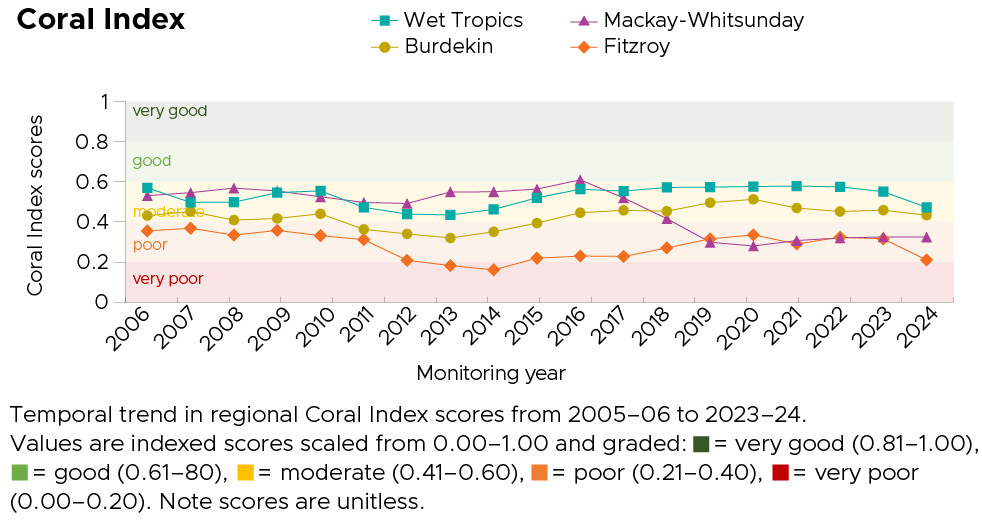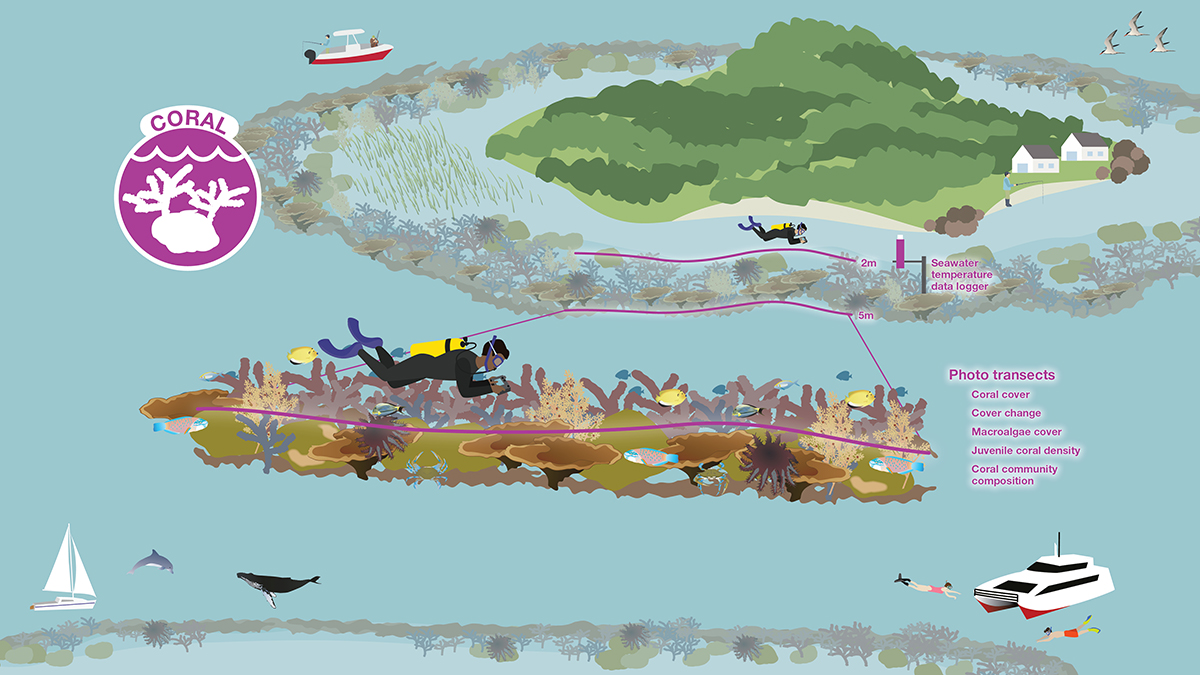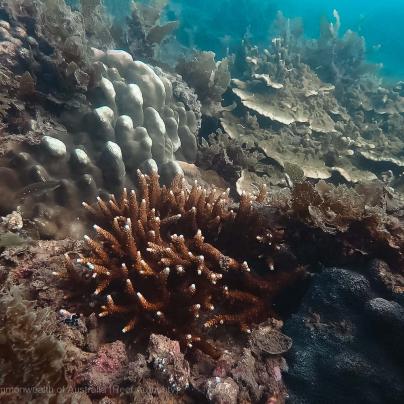Key environmental pressures
High summer sea water temperatures in 2024 impacted inshore coral reefs, with heat stress measures in the Fitzroy region exceeding prior levels recorded for inshore areas of the Reef.
Cyclone Jasper and Cyclone Kirrily impacted inshore reefs in the northern Wet Tropics region and Burdekin regions respectively.
Corallivorous crown-of-thorns starfish were again present on reefs in the Johnstone Russell–Mulgrave sub-region. While their numbers have declined since a peak in 2020, in 2024 crown-of-thorns were observed at ‘outbreak’ densities at Fitzroy Island, High Island and in the Frankland Group. The impact of these starfish on corals was reduced by culling undertaken by the Crown-of-thorns Starfish Control Program.
Read the latest Marine Monitoring Program Annual Inshore Coral Reef Report 2023–24.
How did inshore corals respond?
Reef-wide coral condition for inshore reefs remained in an overall ‘poor’ condition in 2024.
- In the Wet Tropics region:
- Inshore coral communities remain in an overall ‘moderate’ condition.
- Coral condition has declined in each of the three sub-regions.
- In the Barron-Daintree, inshore reefs were severely affected by impacts associated with Cyclone Jasper. Coral condition remained within the ‘moderate’ range for the 2023-24 year but is expected to decline as long-term impacts from the cyclone become more apparent.
- In the Johnstone Russell–Mulgrave sub-region coral condition continued to decline from a high point in 2022. This sub-region has seen loss of coral cover due to cumulative impacts of coral bleaching, Cyclone Jasper, and crown-of-thorns starfish.
- In the Herbert–Tully sub-region, coral condition has continued to decline since 2020 but remains ‘moderate’, partly due to legacy effects from bleaching events in early 2022.
- In the Burdekin region:
- Overall coral condition remained ‘moderate’ having declined from a high point in 2020.
- A slight decline in coral cover was observed due to high water temperatures causing coral bleaching and from the direct impacts of Cyclone Kirrily.
- Macroalgae remained ‘poor’ or ‘very poor’ at most reefs.
- Juvenile coral density remained ‘poor’.
- In the Mackay–Whitsunday region:
- Inshore coral condition was unimproved in 2024 and has remained ‘poor’.
- Recovery from the severe impact of cyclone Debbie in 2017 remains slow and most indicators remained in the ‘poor’ category.
- Signs of recovery are most evident in increasing densities of juvenile corals, but this is primarily at reefs where macroalgae is low.
- At other reefs persistently high cover of macroalgae continues to limit coral recovery.
- In the Fitzroy region:
- Coral condition remained ‘poor’ declining significantly from 2023 with the marine heatwave of 2024 impacting all coral metrics.
- Hard coral cover across the region has declined markedly
- Locations impacted the most were: North Keppel, Barren and Keppels South.
- Macroalgae, although improving marginally, remains ‘poor’ in the region with high coverage of large, brown macroalgae that continues to suppress coral community recovery.

What is monitored?

- At these sites, coral monitoring is conducted by assessing the following indicators:
- coral cover
- proportion of macroalgae
- juvenile coral density
- rate at which coral cover changed
- coral community composition (genus level)
Additionally, signs of bleaching, disease, physical scars from Drupella sp. and crown-of-thorns starfish predation, and any other visible damage are recorded.
- Where is coral condition monitored?
- Wet Tropics
- Burdekin
- Mackay–Whitsunday
- Fitzroy
- Read the Marine Monitoring Program Annual Inshore Coral Reef Report 2023-24.
- Learn more about the coral monitoring methods in the Marine Monitoring Program Annual Report Quality Assurance and Quality Control Manual 2023-24
- Additional site-level information can be found in the AIMS’ Reef dashboard.



